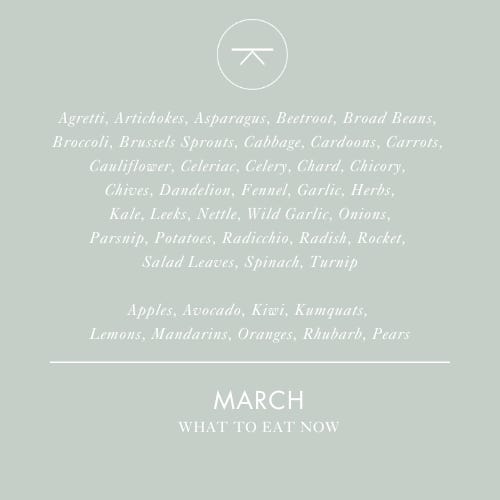Waving Goodbye to Winter Vegetables // Part II
Two Vegan + Gluten-Free Recipes to Savour the Change of Season + Healing Our Inflammation
‘You can't keep one disease and heal two others. When the body heals, it heals everything.’ - Charlotte Gerson
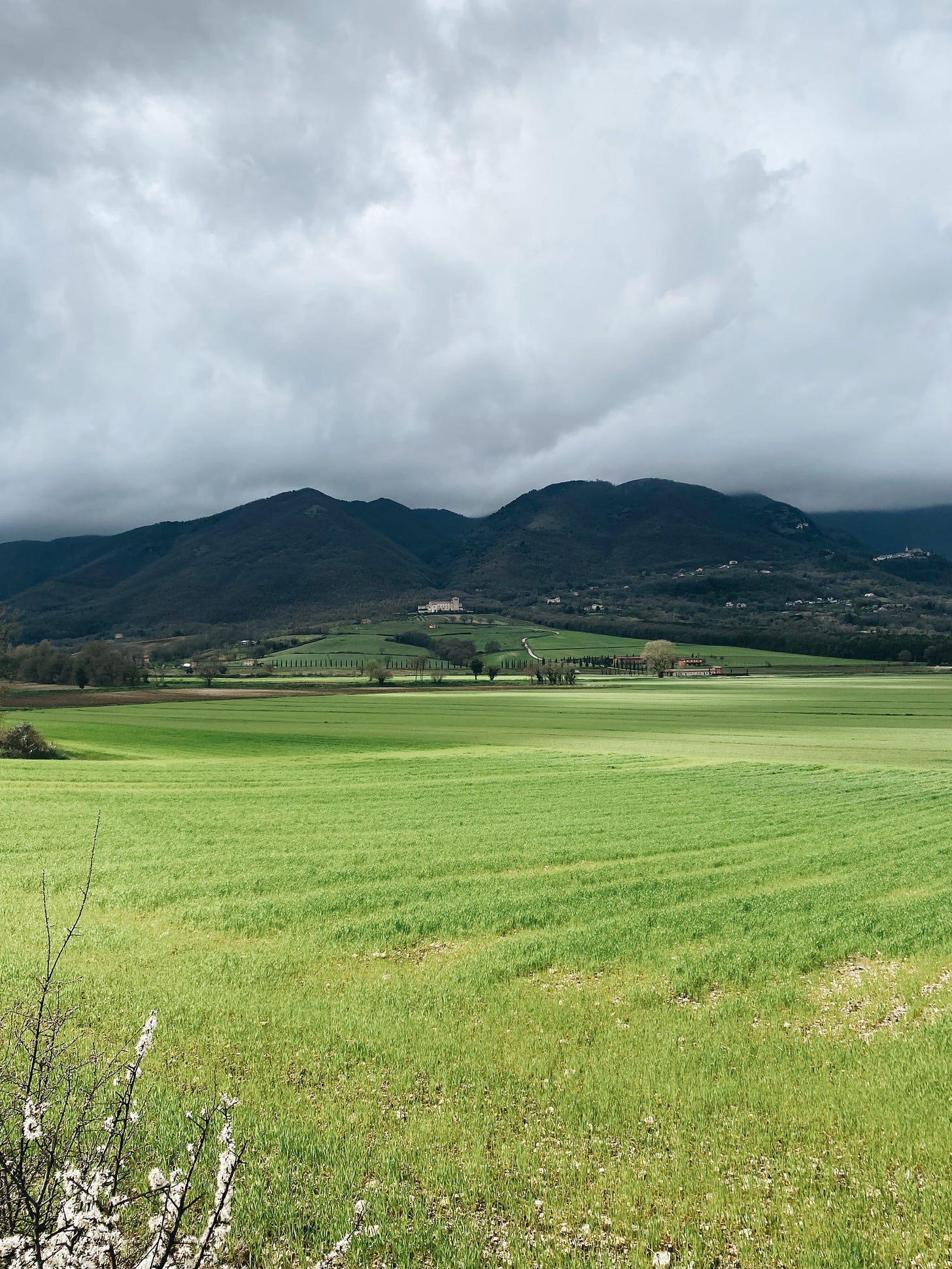
For anyone just joining us here, I recently posted the first part of this piece where I talk about the inflammation of Mother Earth and how this energy extends into women and motherhood. The truth is that this inflammation affects every living thing on our planet and if Elon Musk isn’t proof of this then I don’t know what is! None of us are escaping this inflammatory story anytime soon, but we can try do our part to heal it within ourselves and our world.
I was taught that you have everything to be thankful for in this life if you have a roof over your head, some food on the table, your health and a few good friends. We all have our crosses to bear, this is part of being human. Our capacities vary, everyone’s hard is different, and most of us are armed with what we need to pull through the bad days.
Then there are the extremes of human suffering that go up in degrees like your heating dial.
It seems like most people, especially those with large platforms, are continuing to go about their daily lives as black ink stains continue to spread over this current chapter of humanity. Have we all taken a moment to look up from our recipes and interiors to notice that ‘the ceasefire’ is over? Surely you know the one I am speaking of?
I was prompted to write this two part piece which I was tempted to rename ‘Two End of Winter Recipes for the Global Doom Spiral’ because like so many of us who have not chosen to hit snooze on our alarm clocks (wake up people. wake up.), I can no longer bear to witness the crimes against humanity that are being committed in places like Gaza and the women, children, men, animals and ecosystems that are in a state of extreme suffering as a result of them.
In these inhumane conditions which might even be included in the reflections of hell we see our separateness. But Gaza and Palestine as a whole is not them ‘somewhere over there’. Gaza is us. We are Gaza.
The current situation in Gaza and the surrounding territory is the primary tumour that has grown upon Mother Earth — it is the reflective product of our systemic inflammation and the rot that runs through our veins. For anyone who cares to look, there is a big mirror attached to the tumour to show us just how incredibly sick we have become. We have had numerous chances to examine our conscience, to stand up to injustice and inequality — to say ‘not in my name’. But we didn’t, and now this disease is spreading fast and it’s coming to a theatre near you.
It seems like our global love story gone wrong is going to get much worse before it gets better (the darkest part of the night comes before the dawn right?) and I think most of us are feeling a bit shook by the current state of our world. Are you feeling the looming urgency of this moment? If not, then maybe you should be.
As we collectively ponder as to how we might respond to the crisis of our current diagnosis, we might have a Chris Martin moment and ask ourselves, ‘am I part of the cure? Or am I part of the disease?’(Ba dum tss). We are the living and breathing cells of Mother Earth and we determine whether this disease will continue to spread.
‘What kind of cell do I want to be in this world?’ One that heals or one that inflames?
Then we can take small steps to make ourselves healthy and strong and to open our minds with the understanding that most powerful acts of regeneration in this world are the ones that take place within ourselves.
What can I do today to heal global inflammation? What acts can I take to heal this world of toxic controlling systems that are designed to make us feel like we don’t deserve better?
When we remove everything that makes us unwell, and replace it with what the body need to thrive, there is no other way for us to be but in a state of good health. This principal exists on both micro and macro levels. We have the power to do this.
Vote. Protest. Call. Write. Boycott. Demand. Support. Donate. Plant and Eat Plants.
With the recent passing of St. Patrick’s day, I must say that I am so proud to have the blood and culture of the men and women who fought for Ireland’s liberation coursing through my veins. It is also the same blood that endured oppression, colonisation and genocide with the effects still being felt today. If you tap into the tree of your ancestral heritage and the story of your past, there is a very good chance that the residues of colonisation and genocide run through you too.
Tap into it. Be a good cell. Walk on the moral side of history. Lean into good Karma. Dare to say ‘never again’.
‘Palestine is a wound. What is happening to the Palestinians is a tragedy foretold, and a stain on Israel’s history for which we bear collective responsibility. It is never too late for the world to stand up and do the right thing.’ - Francesca Albanese, Italian International Lawyer and United Nations Special Rapporteur
And what about the inflammation that happens on the inside? Do you suffer from it or love someone who does? Yes?
Well I know I do. Those of you who follow me here may already know that I was diagnosed with the autoimmune disorder that is celiac disease 16 years ago. Unfortunately Acid Reflux aka GERD (super sexy) is how inflammation has been showing up for me on and off for the last 5 years or so.
In my next post I will be talking more about how I have been healing and strengthening my digestive health in order to reduce inflammation. I will also offer some tips that might help some of you dealing with similar issues and include a gut friendly change of the season recipe that I have been testing.
The usual biodiversity of plants, both cultivated and wild, are at the core of the cure to all that ails the universe. Doctors of functional medicine and others in the know, recommend that we consume 30+ plants a week for ultimate gut health. Listen to this podcast and this podcast if you would like to learn more.
This was the diet of our ancestors, and Mother Earth gives us what we need to eat right now in terms of variety and seasonality. Unfortunately, in today’s world this can sometimes be a very tall order.
Dianne Jacobs recently posted about her food restrictions which are now more common than not. I have touched upon the why’s of this in the past and I plan to talk about this again. Good Food inclusion is fundamental and this is why I aim to keep Green Italian Kitchen’s recipes as accessible as possible. I will be including a digestive friendly symbol/label although I still need to work out these details.
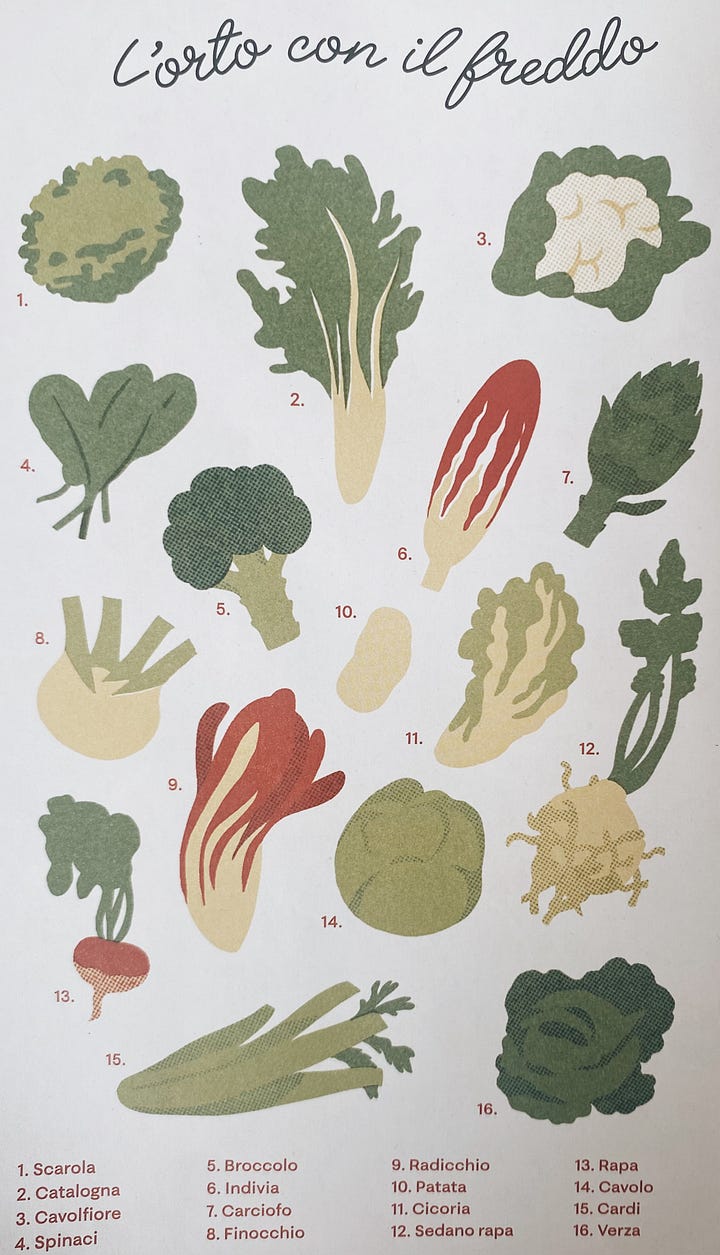
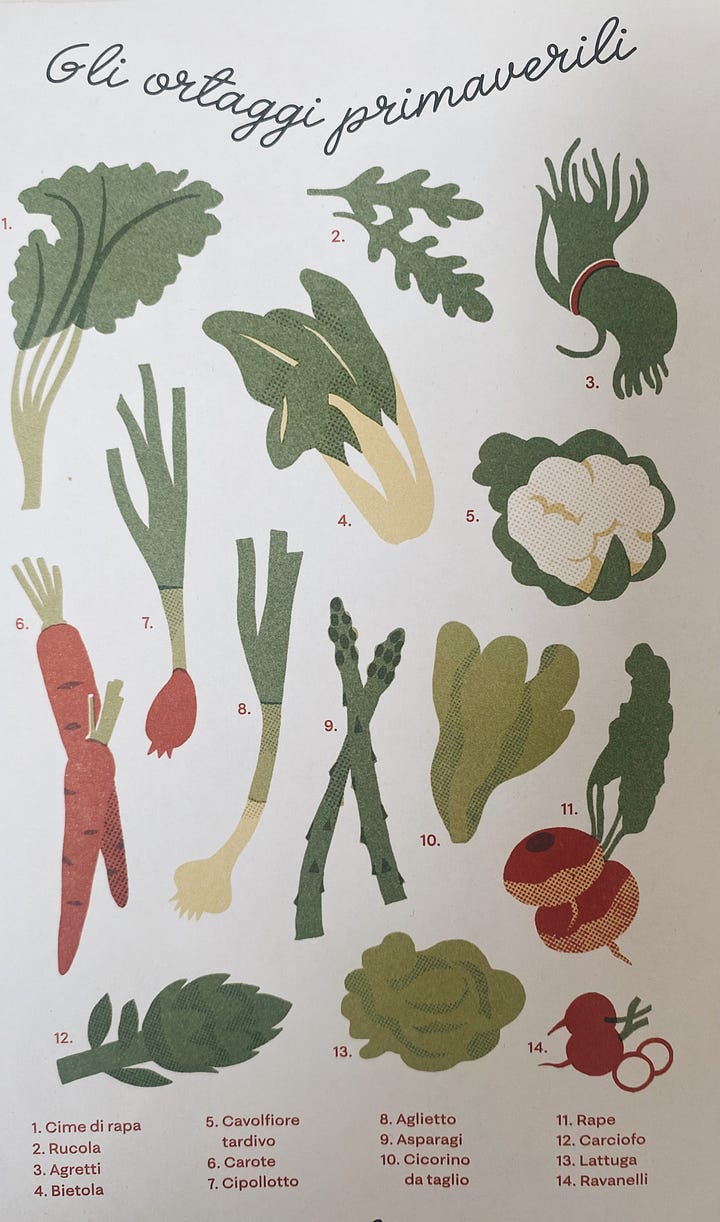
As we move from winter into spring I am trying to indulge in all of the vegetables that I will be missing until next year. This includes radicchio and cruciferous brassicas like cauliflower and broccoli which are full of immune boosting vitamin C, recommended for preventing and fighting cancer and excellent for women going through perimenopause and menopause because they ‘contain indole-3-carbinol—a compound that helps metabolise estrogen in the gut and liver’.
Below you will find two easy vegan and gluten-free recipes to savour the change of the season. These ingredients nourished us over these past few weeks as myself and the children recovered from our chest infections. I hope that you might enjoy them and give thanks as you watch the news grateful that you and your family aren’t being blown to pieces.
Both utilise leek at the base which I recently discovered can be more gentle on the digestive system (more so the green part) as opposed to onion and garlic and still provides mild allium flavour on which so many recipes are built.
Big pots of soup and risotto are welcome on these still chilly days as they always offer a gentle, warming and creative way to get the mixed healing properties of vegetables into your system especially when fish fingers and pizza are also in the mix.
This ‘cream’ of broccoli and cauliflower soup is inspired by the flavour combinations found in the Italian freezer aisle and this one is too. On the evenings when we roll in late from some kind of practice, showers are still in order and the tiredness is hitting hard (thanks to the shift of the internal clock in your late 40’s), I will sometimes warm up a frozen soup and add a jar of beans (because there ain’t no takeout in the Italian countryside baby) as a zero fuss dinner solution. This is the fresh version which is also popular with our kids who often inhale a big bowl of freshly cooked broccoli with their hands.
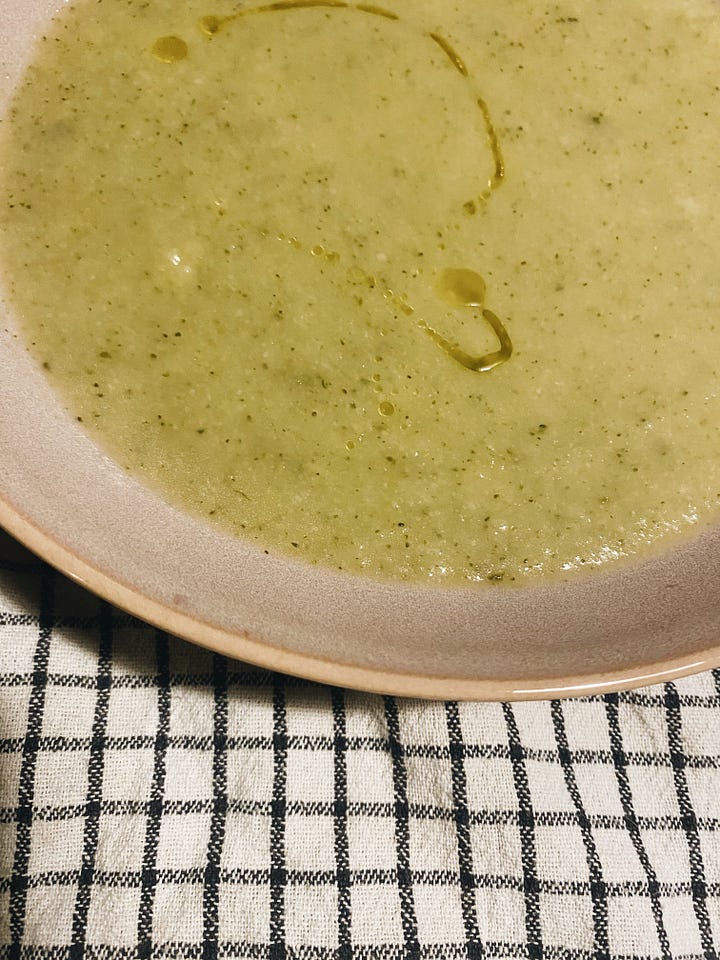
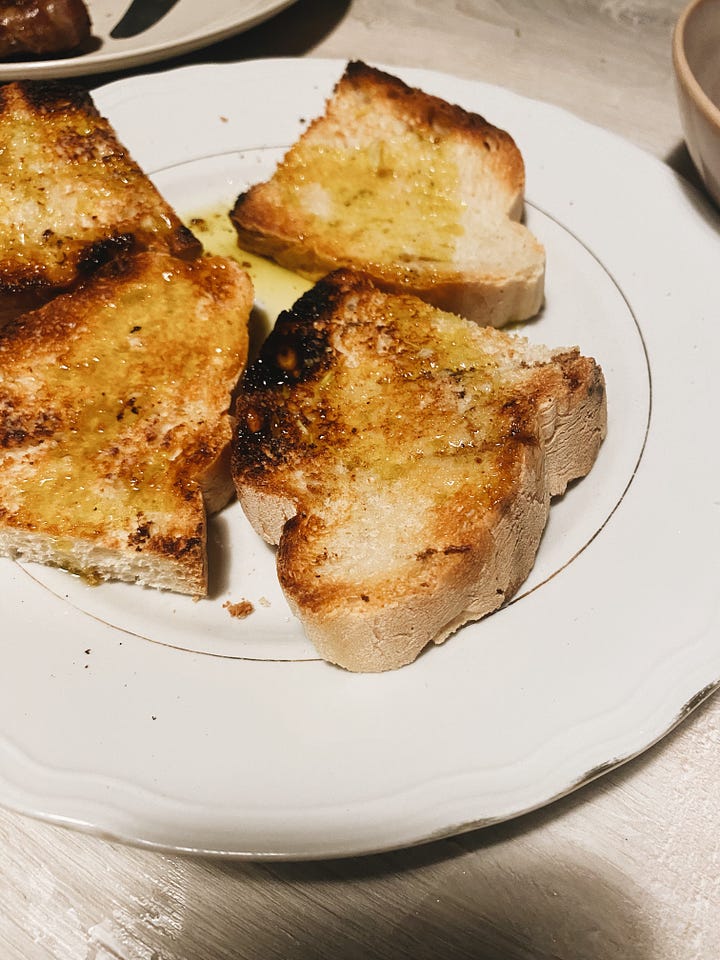
Creamy Broccoli and Cauliflower Soup
Vellutata cavolfiori e broccoli
GF + V
Serves 4-6
Ingredients:
1 kg mixed broccoli and cauliflower*
2 medium potatoes
2 large leeks*
Extra virgin olive oil
1 quality vegetable stock cubes or 1.25L of fresh vegetable stock*
A handful of fresh parsley
Sea salt + freshly ground black pepper
Method:
Rinse the broccoli and cauliflower and cut them into small florets.
Peel and roughly chop your potatoes and wash and thinly slice your leeks.
Gently warm a thin film of olive oil in the bottom of a medium large stock pot.
Add your leeks and a pinch of salt and gently sauté until translucent.
Add your broccoli, cauliflower, potatoes and parsley. Season and stir.
Add your vegetable stock or 1.25L of water and your stock cube.
Bring to a boil and then simmer covered until all of the vegetables are tender.
Blend with a hand blender, check the seasoning and add some boiling water if necessary to reach your desired consistency.
Serve warm.
Notes:
In this recipe I used 500g broccoli, 250g cauliflower and 250g Romanesco broccoli but any combination of broccoli and cauliflower will do.
Garnish with combinations of extra virgin olive oil, freshly grated Parmigiano Reggiano, a fresh squeeze of lemon juice or anchovy breadcrumbs (you can skip the garlic if it’s not for you).
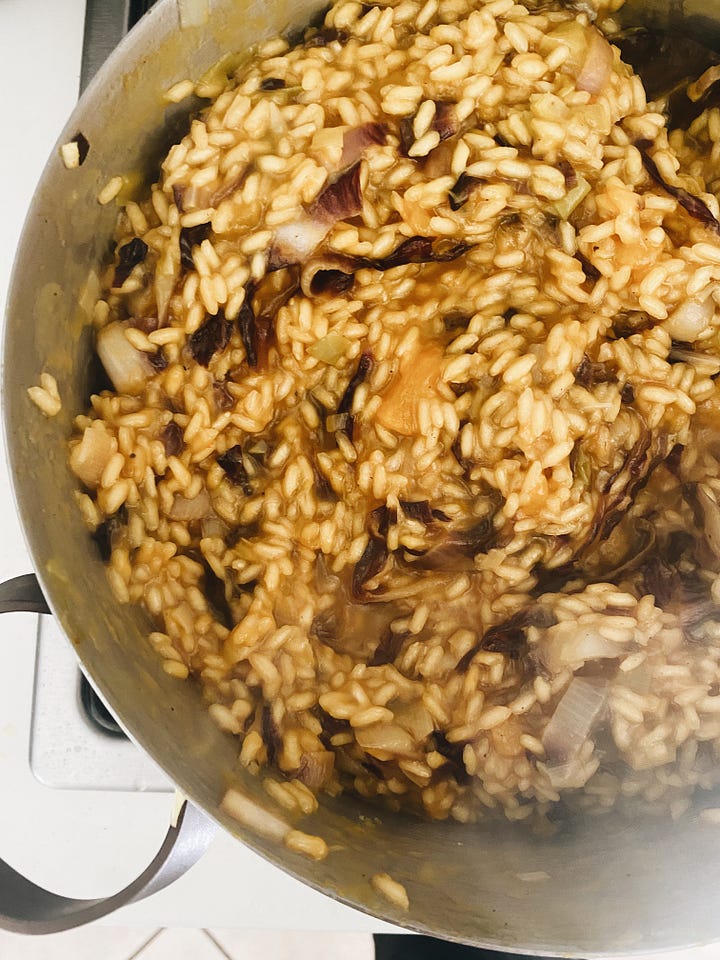
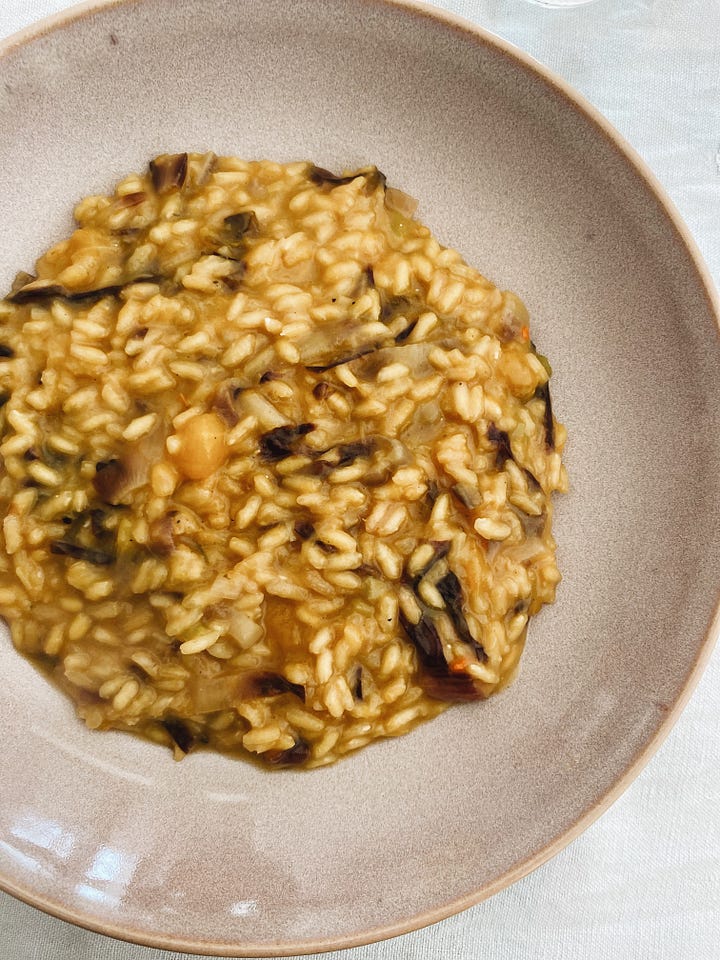
Warming saffron is often a good idea in risotto and the use of sweet leek and butternut squash or pumpkin together with radicchio is a way to balance out that touch of bitterness which isn’t always pleasing to everyone. This combination was inspired by a shot of a similar recipe featured in the via Carota cookbook. We are still seeing squash and pumpkin on the produce stands here in Italy but this is definitely the last hurrah.
Risotto with Radicchio, Leek, Butternut Squash and Saffron
Risotto zafferano, radicchio, porro, zucca e zafferano
GF + V
Serves 4-6
Ingredients:
350g risotto rice, Carnaroli or Vialone Nano
1 large leek
2 large handfuls of radicchio rosso Chioggia tondo or Treviso precoce
The top of a small butternut squash
1 sachet of quality Italian powdered saffron
80ml Italian white wine
Extra virgin olive oil
1 quality vegetable stock cube or 1.5L of fresh vegetable broth
Sea salt + freshly ground black pepper
Optional:
50g of quality butter regular/lactose-free
30g of grated Parmigiano Reggiano, plus more to serve
Freshly chopped parsley or sage*
Method:
1. Add 1.5 litres of water and the stock cube or fresh stock to a medium saucepan, bring to a gentle simmer over low heat.
2. Thinly slice the radicchio, peel and roughly chop the butternut squash and finely slice the leek.
3. Add the squash to the simmering stock.
4. Add a thin coat of olive oil to the bottom of a wide heavy-bottomed saucepan and warm over low heat. Add half of the butter here if using, and when it melts add the leek. Alternatively, add the leek and any desired herbs finely chopped directly to the warm oil.
5. When the leek is translucent, raise the heat, add your rice and stir to coat. Toast until it is shiny and translucent, 2-3 minutes, taking care not to burn.
6. Add the white wine, and stir until it evaporates, then lower the heat.
7. Add the radicchio and then remove the squash from the stock with a slotted spoon and add it to the pan. Keep the stock warm over a low flame.
8. Give the rice a good stir. Add one ladle of stock and then the saffron. Continue addling ladles of liquid as it absorbs gently stirring until the rice is al dente about 20-30 minutes.
9. For the mantecatura: 1. Add a drizzle of olive oil and gently stir with a wooden spoon. 2. Add about ½ cup of creamed vegetable or white beans to stir. 3. Add the other half of your butter and the cheese, then gently shake the pan covered to combine or gently stir.
10. Recheck seasoning, add another splash of hot stock to loosen if necessary and serve immediately.
Notes:
For fresh saffron, soak 1 teaspoon in a cup of water, strain to remove the pistils and add toward the end of the cooking time.






